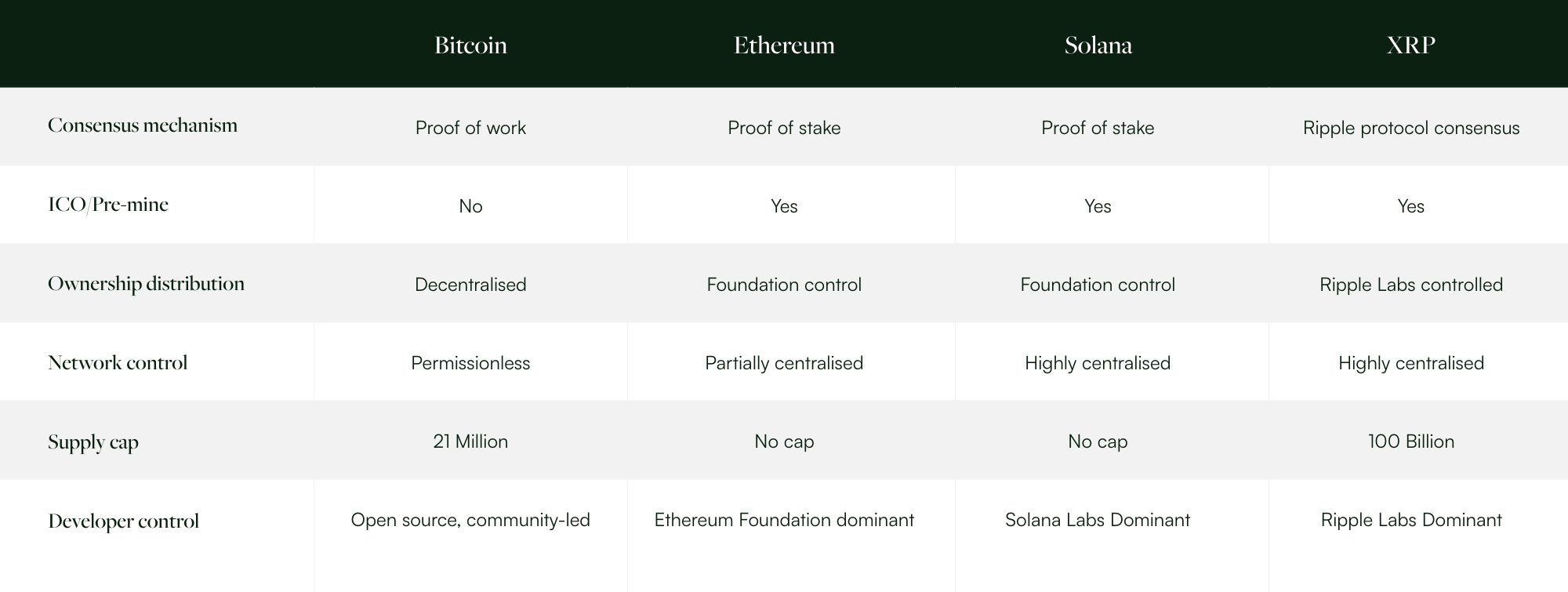In the world of digital assets, the headlines don’t tell the whole story. It’s easy to lump Bitcoin in with the rest of “crypto”—Ethereum, Solana, XRP and the countless tokens that populate the ecosystem. But doing so misses the most important distinction in this emerging financial revolution.
If you’re a high-net-worth individual seeking control over your capital, a hedge against inflation, and insulation from institutional overreach—then this distinction matters deeply. Bitcoin is not just another cryptocurrency. It is, by design, in a class of its own.
Most altcoins—however innovative their pitches—are fundamentally compromised by how they were launched and how they operate.
Ethereum, Solana, XRP and the majority of altcoins began life with a pre-mine or ICO. This means a large percentage of the token supply was created before launch and allocated to insiders—founders, developers, or venture capital backers. This centralisation of ownership is at odds with the idea of a fair, decentralised financial system.
For example:
Altcoins often rely on central foundations or development teams to maintain and evolve their networks. This creates single points of failure—legal, political, or technical. Central control might accelerate development, but it fundamentally undermines resilience, neutrality, and censorship resistance.
Bitcoin had no pre-mine, no ICO, and no controlling entity. It was launched quietly and fairly, giving anyone with a computer the chance to mine and earn bitcoin from day one.
The Bitcoin protocol is secured by proof of work (PoW), and its supply is capped at 21 million coins—forever. No one can change this. Not a government, not a founder, not even a majority of developers.
Its decentralisation is not theoretical—it’s proven. No single entity owns it, controls it, or can shut it down. Bitcoin is permissionless, borderless, and mathematically scarce.
Bitcoin’s security model is grounded in physical reality. To validate transactions and secure the network, miners must expend real-world energy—electricity—and compute power. This energy is a cost and a commitment. It ties the digital world of Bitcoin to the physical world through the universal language of physics.
To simplify: electrons must move; silicon must run hot. This means Bitcoin can’t be counterfeited, gamed, or corrupted by insiders without incurring immense, real cost. Its immutability is rooted in physics, not just code.
PoS systems, by contrast, are virtualised. Power is granted to those who hold the most tokens—which often means those who were given the most tokens early on. Wealth begets more wealth. There is no tie to the physical world, no energy cost, no external anchor. This makes PoS systems cheaper to run but easier to centralise, manipulate, or politically interfere with.
In PoW, you must spend energy to participate. In PoS, you simply own coins. The former mirrors how real-world value is created. The latter resembles corporate governance—a system we already know can be captured.

Bitcoin's design—its decentralisation, capped supply, and proof-of-work consensus—makes it the soundest money humanity has ever created. It is digital, but grounded in physical reality. Transparent, but anonymous. Borderless, but resistant to political capture.
While Ethereum and other altcoins may have compelling use cases or technological experiments, they are not trying to be money. Bitcoin is not trying to “do everything.” It is focused entirely on being the best store of value, medium of exchange, and eventually, unit of account.
As the digital asset space grows, we should expect altcoins to remain. Some may even thrive. But like early internet protocols or dot-com businesses, only a few will retain long-term value.
Bitcoin, however, is protocol-level money. The monetary base of the digital age. BlackRock CEO Larry Fink referred to Bitcoin as “digital gold”—and unlike any altcoin, it’s being adopted by nation states, pension funds, and insurance companies.
Analysts predict the digital asset market could reach $200 trillion over the next two decades. Even if altcoins survive, they will likely be a small fraction of that market. Bitcoin will be the foundation.

Bitcoin is not just another crypto. It is a revolutionary monetary protocol, forged through fair launch, hardened by energy, and defended by decentralised consensus. It is the antidote to inflation, institutional overreach, and financial censorship.
Altcoins may offer novelty—but Bitcoin offers sovereignty.
For those seeking control of their capital in a digital future, don’t mistake noise for signal. Invest where value is secured not by marketing or influence—but by math, energy, and time.
Contact us below or directly oncontact@heliosbtc.comto gain further insights and set up your free discovery call.